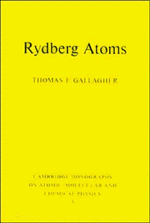Book contents
- Frontmatter
- Contents
- Preface
- 1 Introduction
- 2 Rydberg atom wavefunctions
- 3 Production of Rydberg atoms
- 4 Oscillator strengths and lifetimes
- 5 Black body radiation
- 6 Electric fields
- 7 Pulsed field ionization
- 8 Photoexcitation in electric fields
- 9 Magnetic fields
- 10 Microwave excitation and ionization
- 11 Collisions with neutral atoms and molecules
- 12 Spectral line shifts and broadenings
- 13 Charged particle collisions
- 14 Resonant Rydberg–Rydberg collisions
- 15 Radiative collisions
- 16 Spectroscopy of alkali Rydberg states
- 17 Rf spectroscopy of alkaline earth atoms
- 18 Bound He Rydberg states
- 19 Autoionizing Rydberg states
- 20 Quantum defect theory
- 21 Optical spectra of autoionizing Rydberg states
- 22 Interseries interaction in bound states
- 23 Double Rydberg states
- Index
16 - Spectroscopy of alkali Rydberg states
Published online by Cambridge University Press: 29 September 2009
- Frontmatter
- Contents
- Preface
- 1 Introduction
- 2 Rydberg atom wavefunctions
- 3 Production of Rydberg atoms
- 4 Oscillator strengths and lifetimes
- 5 Black body radiation
- 6 Electric fields
- 7 Pulsed field ionization
- 8 Photoexcitation in electric fields
- 9 Magnetic fields
- 10 Microwave excitation and ionization
- 11 Collisions with neutral atoms and molecules
- 12 Spectral line shifts and broadenings
- 13 Charged particle collisions
- 14 Resonant Rydberg–Rydberg collisions
- 15 Radiative collisions
- 16 Spectroscopy of alkali Rydberg states
- 17 Rf spectroscopy of alkaline earth atoms
- 18 Bound He Rydberg states
- 19 Autoionizing Rydberg states
- 20 Quantum defect theory
- 21 Optical spectra of autoionizing Rydberg states
- 22 Interseries interaction in bound states
- 23 Double Rydberg states
- Index
Summary
In the first two chapters we have seen that the Na atom, for example, differs from the H atom because the valence electron orbits about a finite sized Na+ core, not the point charge of the proton. As a result of the finite size of the Na+ core the Rydberg electron can both penetrate and polarize it. The most obvious manifestation of these two phenomena occurs in the lowest ℓ states, which are substantially depressed in energy below the hydrogenic levels by core penetration. Core penetration is a short range phenomenon which is well described by quantum defect theory, as outlined in Chapter 2.
In the higher ℓ states the Rydberg electron is classically excluded from the core by the centrifugal potential ℓ(ℓ + 1)/2r2, and, as a result, core penetration does not occur in high ℓ states, but core polarization does. Since it is not a short range effect, it cannot be described in terms of a phase shift in the wave function due to a small r deviation from the coulomb potential. However, the polarization energies of each series of nℓ states exhibit an n–3 dependence, so the series can be assigned a quantum defect. Unlike the low ℓ states, in which the valence electron penetrates the core, measurements of the Δℓ intervals of a few high ℓ states enable us to describe all the quantum defects of the high ℓ states in terms of the polarizability of the ion core.
- Type
- Chapter
- Information
- Rydberg Atoms , pp. 340 - 364Publisher: Cambridge University PressPrint publication year: 1994
- 3
- Cited by



